




|
Structural Fire Engineering ?
Those aspects of fire engineering concerned with structural design for fire, and
the complex interaction between a building's structure and fabric, i.e. non-structure,
under conditions of fire and its aftermath.
World Trade Center Incident (9-11)
&
Fire Serviceability Limit States

New York - Tuesday, 11th September 2001 Examine the NIST Recommendations on the WTC Tower Collapses
and our Technical Comments (2011)
| Why did this building collapse after such a short time ? |
| Why did it collapse at all ? |
Will this type of incident ever happen again ?
(will anybody fly a plane into a tall building ?) |
|
It already has ...... |
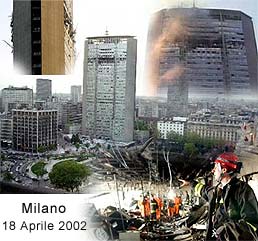 |
Plane Impact - Pirelli Tower in the Centre of Milan, Italy
(building remained standing)
Tuesday, 6th December 2005
Iranian Military Transport Plane (US Built C-130) Partially Impacts
10 Storey Apartment Building in Tehran, Iran.
Sunday, 4th October 1992
Israeli El Al Cargo Plane (Boeing 747) Impacts & Partially Destroys
12 Storey Apartment Building at Amsterdam (Bijlmermeer), in the Netherlands.
On the Crashed Plane - Depleted Uranium & Component
Material for Chemical Weapons.
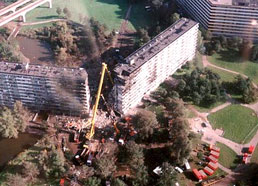
October 2003 Conference Paper
Medical Investigation into the Bijlmermeer Aviation Disaster
& Depleted Uranium
Henk van der Keur & Ed Steur
Bali - 12th October 2002
This incident confirms a pattern which began before 9-11 in New York.
Building Codes, Standards & Practices After 9-11
'Cost Effectiveness' has, in the past, seriously compromised the health of
building users and the safety of firefighters.
In the NIST Final Report on the WTC 1 & 2 Collapses ...
Building Owners & Public Officials are strongly urged to take the steps necessary to mitigate any unwarranted risks without waiting
for changes to occur in Codes, Standards and Practices.
Once 'vested interests' get involved, it may take another 5-7 years (from 2006)
before these codes, standards and practices are satisfactorily revised,
and properly implemented.
20th February - 2nd March 2006
C.J.Walsh Keynote Paper on
'Fire Engineering Practice After 9-11'
at an Arab Region Workshop, in Saudi Arabia, for Architects
and Engineers representing Government Ministries.
As a parallel concept to 'Maximum Credible Fire Scenario' ....
we propose that Maximum Credible User Scenario must be introduced,
representing user conditions which are also severe
but reasonable to anticipate.
The New Fire Engineering Design Benchmark should be ....
10% of People Using a Building (occupants, visitors and other users)
have
an Activity Limitation (visual or hearing impairment,
physical function impairment, mental or cognitive impairment),
with some limitations not being identifiable ....
and ....
the Actual Number of People Using a Building increases,
on occasions which cannot be specified,
to 120% of calculated maximum building capacity.
[ Has anyone ever seen a 'real' Irish Pub on a Friday night ??? ]
Future Liability of Building Designers
Structural Design for Fire, and Fire Engineering Design generally,
must improve dramatically. It must be shown, in Building Designs
commenced after 9-11, that 'Progressive Collapse in Fire' and
'Disproportionate Damage' have been adequately considered
... and will be prevented.
CIB W14 Discussion Document - November 2003
As Building Designers and Fire Engineers .... how do we pick up
the pieces after 9-11, and move forward again ? Repeating
the same old mistakes is no longer acceptable.
Existing Multi-Storey and/or Culturally Iconic Buildings
National Programmes must be established to appraise the
Structural Performance of Existing Multi-Storey Buildings under Ambient
and Fire Conditions.
What is their approximate level of resistance to ....
• Disproportionate Damage ?
• Progressive Collapse in Fire ?
Is that level adequate and sufficient ?
The Future Will Be Integrated Trans-Disciplinary Design
Download an Interesting Magazine Article, in French,
from Bâtiment et Sécurité (October 2005) which demonstrates one such approach......
Tour Polycentrique: Solution à la Sécurité des IGH ?
(The Polycentric Tower: A Solution to Safety in Very Tall Buildings ?)
Click Here to Download PDF
(PDF File, 354kb)
|
|
New York 9-11
With stunning impact, we were presented with a Collapse Level Event
(CLE) in building technology. This is a common occurrence in some parts
of the globe, but very unusual just a short distance from Wall Street
and right in the glare of the world's television cameras. As far as the
general public in the USA (and outside the USA !) is concerned, these
collapses were unacceptable.
On 11th September 2001, a catastrophic failure was exposed, at all levels, in current practices and procedures ......
- Architectural ;
- Structural
& Fire Engineering - the World Trade Centre Towers themselves
should not have collapsed, and adjoining buildings certainly should not
have been affected to the extent seen ;
- Building Management - some people escaped, but this was in spite of evacuation procedures in the WTC Complex ;
- Emergency
Services - they appeared to have little understanding of building
structural behaviour, and to have almost no grasp of the concept of
'place of safety' (as it would be applied to First Responders) ;
- Control
Organizations Having Authority / Jurisdiction turned a 'blind eye' to
the full lessons of the 1993 bombing of the Centre ;
- Fire Safety Objectives in existing building codes and standards are fatally flawed, and entirely inadequate ;
- The
International Fire Research Community must finally begin to deal with
'real' buildings, and the 'real' people who inhabit and use them.
'Real' people have a very wide range of abilities in any situation.
Special emphasis must, therefore, be placed on protection of people with activity limitations .
[ May, 2004 - 11th Public Hearing Proceedings of the 9-11 Commission ]
Staff Statement No.13
Emergency Preparedness & Response
Click Here to Download PDF
(PDF File, 201kb)
In mid-October 2001, our Chief Technical Officer CJ Walsh visited Manhattan in New York, and stayed in Battery Park City (within the restricted zone).
[ A very close relation of his was working in one of the WTC Towers on
11th September .... by sheer chance, two other cousins were elsewhere
that morning.]
He also met with a senior structural engineer directly involved in the clear-up of the WTC Incident Site.
May 2002 - Even yet, some of the right questions remain to be asked about what precisely happened on that sunny, fateful Tuesday.
Slowly,
some answers are beginning to appear. Unfortunately, there are so many
vested interests involved .... faces to save .... and 'sacred cows' to
protect.
November 2002 - The Official NIST(USA) WTC Investigation must not only be completely independent ..... it must be clearly shown to be so.
We
would like to look here at one or two aspects of structural design for
fire, and the inadequacy of some current fire engineering concepts.
We have raised these concerns before - see the extended version
of our contribution to CIB Report No.269 (October 2001) ....
Subjects in brackets are located elsewhere on this WebSite.
- Structural Reliability & Fire Serviceability Limit States
- ( Fire Resistance Performance in Buildings )
- ( Design to Resist Progressive Collapse in Fire )
In
Ireland during the 1980's, considerable multi-disciplinary research and
development work relating to 'progressive collapse in fire' was carried
out. Three full scale building fire tests took place in 1982, 1983 and
1985. A Paper was presented at the 1987 Dublin Fire Conference. A section dealing with this issue was also inserted into the Irish Standard Masonry Code (IS 325 : Part 2) by CJ Walsh.
Progressive Collapse is a related, but different structural concept to Disproportionate Damage ......
Fire-Induced Progressive Collapse
The
sequential growth and intensification of distortion, displacement and
failure of elements of construction in a building - during a fire and
the 'cooling phase' afterwards - which, if unchecked, will result in
disproportionate damage, and may lead
to total building collapse. |
| Progressive collapse can commence before a breach in the 'integrity' of a fire compartment. |
Disproportionate Damage
The failure of a building's structural system ......
(i) remote from the scene of an isolated overloading action ; and
(ii) to an extent which is not in reasonable proportion to that action.
- Design to Resist Disproportionate Damage
An
adequate tie - in ambient or fire conditions - between vertical and
horizontal structural elements is a fundamental principle of all
structural design !
Poor connections
between, on one end, the steel truss supported floor units and the
vertical perimeter steel structure, and on the other end, between the
floor units and the building core steel structure, were an important
factor in the scale of damage to
WTC 1 and WTC 2.
- ( One Year Later - October 2002 Presentation by CJ Walsh in Sweden )
For the first time, the above new structural design definitions were
presented in an International Fire Engineering Context.
- CIB W14 : Fire
A meeting of this important CIB Working Commission took place in Paris on 10th & 11th September 2002 ....
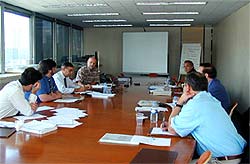
The purpose of the meeting was to decide on the organization of a joint Work Item with ISO TC92 : Fire Safety,
and other international bodies, to develop engineering methods for the
prediction of structural fire resistance as an alternative to ISO 834 / ASTM E119.
The following issues were discussed at the meeting, amongst others :
| - |
Structural Reliability
.... and relating performance in standard fire tests, and as calculated
or modelled, to 'ultimate limit state' and 'fire serviceability limit
states' in limit state structural design. This will also permit the
necessary communication to take place between building designers, fire
engineers and mainstream (ambient) structural engineers ;
|
| - |
Role of the Mainstream (Ambient) Structural Engineer .... as a member of the Design Team, he/she must become involved in considerations of structural performance in fire ;
|
| - |
Design Fires
.... caution must be exercised with use, and everyone should be aware
of their limitations. It is the responsibility of the Design Team to
decide on the appropriate fire scenario(s) for a particular
construction project ;
[ This
is an 'alien' concept to those people who work with the
overly-prescriptive US Building and Fire Codes ! ]
|
| - |
Fire-Induced Progressive Collapse in Fire .... concept will be defined and further developed ;
|
| - |
Resistance to Disproportionate Damage Caused by Fire .... concept will be defined and further developed ;
|
| - |
Design Guidance
.... must also include 'simple design guidelines' - as the majority of
practicing designers (architects, engineers, etc.) do not operate as
part of a large organization and, therefore, do not have the time or
resources to use elaborate computer models in everyday work ;
|
| - |
Reliability of Computer Models .... this issue remains unresolved at international level. |
As discussed at the 2002 Paris Meeting of CIB W14, a Discussion Document was drafted by CJ Walsh in November 2003.
[
This Document will be discussed at a CIB W14 Conference Session, which
will be organized in conjunction with the next triennial CIB World
Building Congress in Toronto, Canada - 2nd to 7th May, 2004. ]
A pan-European & North American Research Project will be proposed, and developed.
- ( Protection of the Environment )
The
pall of smoke coming from the WTC Incident Site on 11th September 2001
could be seen by satellite from outer space. Weeks later in the middle
of October and in overcast conditions, the 'post-fire' smell was still
very bad and a lot of sickening dust remained clogged in the air.
Services, infrastructure and transport were knocked out in that entire
section of Manhattan. It was a ghost town south of Canal Street.
Effects on the people of New York were serious .... some effects will
be long-term.
- Some General Comments & Questions
- WTC Investigation Reports - 2001 & 1993 Incidents
- National Commission on Terrorist Attacks upon the United States
- Concluding Statements
|
| |
January 2006 - Beginning the integration of Chapter 9 of the NIST Report (Pages 201-230)
into this WebPage .... where any of the NIST Recommendations exceed, add to
or usefully re-inforce our existing content.
In Our Opinion .... there is a surprising strength and directness of language in the
Recommendations of the NIST WTC 1 & 2 Final Report.
And while older minds may still remember the 3 R's of a Good Education,
the NIST Recommendations will also be remembered for their 3 R's :
Reality - Reliability - Redundancy
-
The Report raises fundamental questions about inadequate Fire Engineering Practice
- not just in the USA, but internationally.
-
The Professional Fire Engineer must in future act as a full member of an
Integrated Multi-Disciplinary Building Design Team.
-
The Report does not succeed in properly distinguishing between the
structural concepts of 'progressive collapse in fire'
and 'disproportionate damage'.
-
In its treatment of 'disability' and 'people with activity limitations',
the Report does not go far enough, and is seriously flawed.
To improve clarity, some alterations have had to be made
to technical terms and quoted text.
Please compare with the original NIST NCSTAR 1 Report.
NIST's Recommendations Following the Federal Building and Fire
Investigation of the World Trade Center Disaster
August 2008 - NIST NCSTAR 1A
Federal Building & Fire Safety Investigation of the World Trade Center Disaster
Final Report on the Collapse of World Trade Center Building 7
Click Here to Download PDF
(PDF File, 7.52Mb)
NIST NCSTAR 1A is the more stark report, from the point of view of the everyday fire engineering design of all buildings.
According
to Mr. Shyam Sunder, Lead Investigator with NIST, at a Press Briefing
for the launch of this Report on 21st August 2008 …
” The
collapse of WTC 7 has been a source of extensive speculation. No
planes hit the building. There was damage to the building from
the collapse of World Trade Center Tower 1, which was approximately 110
metres to the south. But despite damage that severed seven
exterior columns, Building 7 remained standing.
The
debris from Tower 1, however, started fires on at least 10 floors of
the building. The fires burned out of control on six of these ten
floors for about seven hours.
The
New York City water main had been cut by the collapse of the two WTC
Towers (WTC 1 & 2), so the sprinklers in Building 7 did not
function for much of the bottom half of the building.
Nevertheless, other tall office buildings have burned for as long or
longer in similar fires without collapsing - when sprinklers either did
not exist or were not functional.”
His main message of the day was …
” World Trade Center Building 7 collapsed because of fires fuelled by
common office furnishings. It did not collapse from explosives or
from diesel fuel fires.
Building
7 collapsed because fires - similar to those experienced in other tall
buildings - burned in the absence of water supply to operate the
sprinklers, and burned beyond the ability of firefighters to control
fires. It fell because thermal expansion, a phenomenon not
considered in current building design practice, caused a Fire-Induced Progressive Collapse.”
April
2005 - NIST Media & Public Briefing on the Federal Building &
Fire Safety Investigation of the World Trade Center Disaster
132 Page Overhead Presentation
Click Here to Download PDF
(PDF File, 6.85Mb)
June 2004 - Progress Report on the Federal Building & Fire Safety Investigation
of the World Trade Center Disaster
Executive Summary (19 Pages)
Click Here to Download PDF
(PDF File, 96kb)
Direct Link to the Official NIST(USA) WTC Investigation WebSite
May 2003 - NIST Special Publication 1000-3
Progress Report on the Federal Building & Fire Safety Investigation
of the World Trade Center Disaster
Click Here to Download PDF
(PDF File, 2.14Mb)
May 2002 - FEMA
WTC Structural & Fire Investigation Report
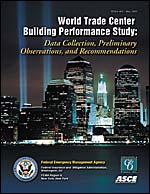
Direct Link to Official FEMA Report on the WTC Collapses
This
Report should only be regarded as being preliminary. The Building
Performance Study (BPS) Team was not sufficiently multi-disciplinary,
independent or impartial. Large areas of investigative detail are
missing in the Study. Many recommendations are too general.
Firm conclusions of any sort are scarce.
1993 - NFPA
Fire Investigation Report
World Trade Center Explosion & Fire
26th February 1993
Click Here to Download PDF
(PDF File, 890kb)
Direct Link to the 9-11 Commission WebSite
( National Commission on Terrorist Attacks upon the United States )
11th Public Hearing in New York on 18th-19th May, 2004
Structural Reliability
&
Fire Serviceability Limit States
Initial reference, and the starting point for a consideration of Fire
Serviceability Limit States, should be made here, with this version of
International Standard - ISO 2394 .........
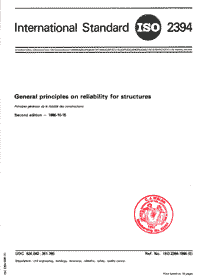
ISO 2394 : 1986 with Addendum 1 : 1988.
(Principes generaux de la fiabilite des constructions)
An
issue which is becoming increasingly critical, in striving to
rationalize, analyse (as distinct from assess), improve and optimize
fire performance in buildings, is that of 'reliability'. Can we
confidently depend on an element of construction, an installed product
or component, or a building system to perform as expected whenever a
fire might occur - at any stage in the life cycle of that building
? Design, construction workmanship, maintenance, 'real' intended
use, and an economically reasonable working life for the building, are
important factors which must be considered also by the fire engineer as
a member of a project's design and construction teams.
In
general terms, the reliability of a building structure, i.e. the
loadbearing construction, is the ability to fulfil its architectural
design purpose for some specified time under the actual environmental
conditions encountered in the building. However, the performance of a
whole structure or part of it, including its performance during and
after a fire, may be more precisely specified in engineering terms by
reference to a defined set of limit states beyond which the structure
no longer satisfies the project's requirements, be they architectural
or fire engineering.
'Real'
buildings comprise structure and fabric, i.e. non-structure, in an
architectural relationship. Under fire conditions, this relationship
becomes an intense and complex interaction, which in nearly all cases
impacts on the functional efficiency, or fire performance, of both.
See Figure 6b in a related conference paper .
Refer to ISO 2394 - General Principles on Reliability for Structures as an agreed basis for the limit state design of building structure.
Those limit states may be divided into the following two categories :-
| (a) |
ultimate limit states,
which in 'cold form' structural design correspond to maximum load-
bearing capacity but, typically, in design for fire still correspond to
the 'near-maximum' (?) loadbearing capacity intended to avoid damage to
laboratory furnaces caused by test specimen collapse - see definitions
of 'failure' in fire resistance test standards ;
|
| (b) |
serviceability limit states,
which in 'cold form' design correspond to criteria governing function
related use but, unfortunately, in design for fire are not yet even
recognized.
|
Ultimate limit states in fire engineering should instead be equally understood to mean, for example .....
-
rupture of critical sections of the structure caused by exceeding the
ultimate strength (in some cases reduced by repeated loading), or the
ultimate deformation of the material ;
- transformation of the structure into a mechanism (collapse) ;
- loss of stability (buckling, etc).
Serviceability limit states in fire engineering,
which are of more immediate and direct relevance to the protection of
both human health and property, and necessary re-construction after a
fire, would correspond to, for example .....
- deformations which affect the efficient use, i.e. the fire performance, or appearance of structural or non-structural elements ;
- local
damage (including spalling and cracking) which reduces the durability
of a structure or affects the efficiency or appearance of structural or
non-structural elements.
To
control 'hot form' serviceability limit states by design, therefore, it
is necessary to use one or more constraints which describe acceptable
deformations (+/-deflection, expansion, distortion, etc),
accelerations, crack widths, spalling, etc.
A
fundamental starting point in structural design for fire, therefore,
must be to properly separate the concept of 'structural reliability'
from the concept of 'fire resistance'. This is discussed in more detail elsewhere.
Structural Reliability :
(ISO 2394) |
The ability of a structural system to fulfil its
design purpose, for a specified time, under the actual environmental conditions encountered in a building. |
In
structural fire design, the concern must be that the structure will
fulfil its purpose, both during the fire - and for a minimum period
afterwards, during the 'cooling phase'.
|
Fire Resistance :
|
The
inherent capability of a building assembly, or an element of
construction, to resist the passage of heat, smoke and flame for a
specified time during a fire. |
Some General Comments & Questions
- Spalling of Concrete
Reinforced
concrete structural elements, or fire resisting elements of
construction, must be designed in such a way that spalling is reduced
to a minimum, if not prevented altogether.
- The Multi-Storey Steel Framed Building Fire Tests at the Building Research Establishment Facility, Cardington, England
A European Joint Research Programme ~ 6 Fire Tests ( BS/ECSC & BRE
) were carried out between January 1995 and July 1996.

Report published in 1999.
Was this just an expensive public relations exercise on the part of the European Steel Industry ?
After the WTC Incident (9-11), we can now say that it was. |
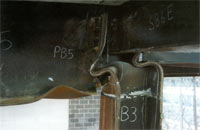
In the above Report, this is described as .......
' Squashing of the exposed part of the column. (Note: the original
extent of the protection can be defined from the white residue line around the column) '
How long would any non-loadbearing, fire resisting
construction have functioned effectively in the vicinity of this failure
of the building's steel frame ? |
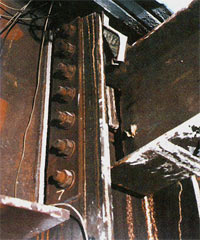
In the above Report, this is described as .....
' Connection where the beam web has detached itself from the end-plate
during the cooling phase of the fire'
Why is there no emphasis placed on Structural Reliability during the period immediately after a fire ? |

In the above Report, this is described as ....
' Internal view of compartment following the test '

In the above Report, this is described as ....
' Cracking of the composite slab around internal column '
This sort of damage to the adjoining building space above the fire compartment is ridiculous, and completely unacceptable. |
Compartmentation (Fire)
The division of a building into fire-tight compartments, by fire and smoke resisting elements of construction, in order ... |
- to contain an outbreak of fire, and to facilitate effective firefighting ;
- to prevent damage, within the building, to other adjoining compartments and/or spaces ;
-
to protect a compartment interior from external fire attack, e.g. fire
spread across the building's facade or from an adjacent building ;
- to minimize adverse, or harmful, environmental impacts outside the building.
|
Notes: In a fire situation, Progressive Collapse may commence
before any breach of 'integrity' occurs in the boundary of a Fire Compartment.
A Fire Compartment means the compartment of fire origin.
Statement - 1
Unprotected steel is prone to Progressive Collapse.
All structural steelwork must be properly
protected from fire.
In 'real' buildings, this also means that fire protection
must be able to withstand mechanical damage
- before and during a fire.
A fundamental re-examination of lightweight fire protection
methods is now very necessary.
NIST WTC 1 & 2 Final Report - Recommendation 10
NIST
recommends the development and evaluation of new fire resisting (steel
protection) coating materials, systems, and technologies with
significantly enhanced performance and durability
to provide (fire) protection following major events.
[ Footnote 34 suggests that Sprayed Fire Resisting Materials
could be encapsulated by highly elastic energy absorbing membranes, or commodity grade carbon fibre, or other wraps. ]
|
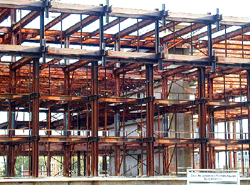
October 2004
European Court of Justice in Luxembourg
Composite Steel Frame & Concrete Core Construction
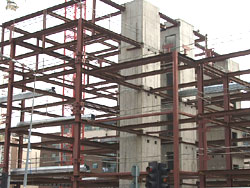
October 2007
Typical Multi-Storey Building Now in Construction - Dublin, Ireland
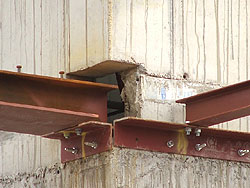
But Pay Attention .... The Integrity of the Concrete Core
Must Not Be Compromised !
And when will Ambient Engineers ever begin to understand the
Structural Behaviour of Steel at High Temperatures ?
Do those steel/concrete junction details look familiar ?
Statement - 2
Serviceability limit state design of structure
for fire must become the norm.
Following the WTC Incident (9-11),
the concepts of 'resistance to progressive collapse'
and 'resistance to disproportionate damage'
must be comprehensively introduced to all
aspects of fire engineering education and practice.
NIST WTC 1 & 2 Final Report - Recommendation 1
NIST recommends that: (a) progressive collapse
be prevented in buildings; and (b) a standard methodology be developed
to reliably predict the potential for complex failures in structural
systems
subjected to multiple hazards (at the same time).
NIST WTC 1 & 2 Final Report - Recommendation 1a
Progressive collapse is addressed only in a very limited way in
(current) practice, and by (current) codes and standards. NIST
recommends that initiating events at multiple locations within the
structure should be analyzed commensurate with the risks
considered in the design.
NIST WTC 1 & 2 Final Report - Recommendation 1b
A robust, integrated predictive capability should be developed,
validated and maintained to routinely assess the vulnerability of whole structures
to the effects of credible hazards. This capability to evaluate
the performance and reserve capacity of structures does not exist, and
is a significant cause for concern.
NIST WTC 1 & 2 Final Report - Recommendations 4 & 9
NIST recommends the development of standards and code provisions to
enable the design and retrofit of structures to resist
'real' building fire conditions, including their ability to achieve
the (fire engineering design) objective of burnout in a
'maximum credible fire scenario', without structural
or local floor collapse .... recognizing that sprinklers could be
compromised, not operational, or non-existent.
[ Footnote 26 states that a 'maximum credible fire scenario'
includes conditions which are severe,
but reasonable to anticipate. ]
Non-robust, 'soft core' construction is only adequate
in small, very simple buildings types.
If bolting is used to connect steel members in steel-frame construction, sufficient welded connections
must be located at strategic parts of the frame.
With
regard to the protection from fire of people using a building
(occupants, visitors and other users), a building's capacity to
accommodate a 'maximum credible user scenario' during a fire incident, i.e. conditions which are severe but reasonable to anticipate, must be clearly shown.
All evacuation routes in buildings must be designed to
Accessibility Design Standards.
NIST WTC 1 & 2 Final Report - Recommendation 17
NIST recommends that stairwell capacity and stair
discharge door width should be adequate to accommodate contraflow due to emergency access
by firefighters/rescue teams.
[ Footnote 39. NIST found that the average surviving occupant
in the WTC Towers descended stairwells at about half the slowest speed
previously measured for non-emergency evacuations. ]
|
Ethical Engineering Design
The Citicorp Skyscraper Tower in New York
&
Accidental Discovery of the Change from Welding to Bolting
Statement - 3
Following
the WTC Incident (9-11), fire engineering and conventional ('ambient')
structural engineering must be seamlessly integrated.
NIST WTC 1 & 2 Final Report - Recommendation 28
NIST recommends that the role of 'Design Professional in Responsible Charge' be clarified.
[ Footnote 49 states that the 'Design Professional in
Responsible Charge' ensures that All Members of the Building Design
Team use consistent design data and assumptions,
co-ordinates overlapping specifications, and serves as
the liaison between all parties involved in the project,
including enforcement and review officials, and the client
or client organization. ]
Still one more conceptual leap is required -
to ensure that real structural performance is
'reliability-based' .... all related engineering
disciplines must gear up to understand and practice
Sustainable Engineering, i.e. Ethical Engineering Design.
|
WebSites of Related Interest
OnLine Ethics Center for Engineering & Science - USA
Centre of Advanced Fire Safety Science & Technology for Building - Japan
Centre Technique Industriel de la Construction Métallique - France
FABERC - Fire and Building Education Resource Collection (USA)
World Trade Center Health Registry - (USA)

|
You will need Adobe Acrobat Reader to view the PDF files. Accessibility of PDF for people with disabilities. |

home | sustainability | fire | architecture | copyright | synchronicity
search this site | back to top | update | contact | technical blog
© Sustainable Design International Limited 1995-2011
all rights reserved - tutti i diritti riservati
|
